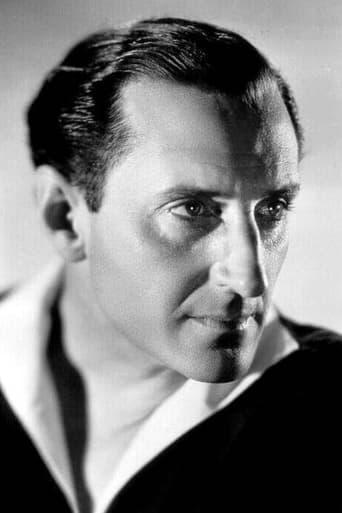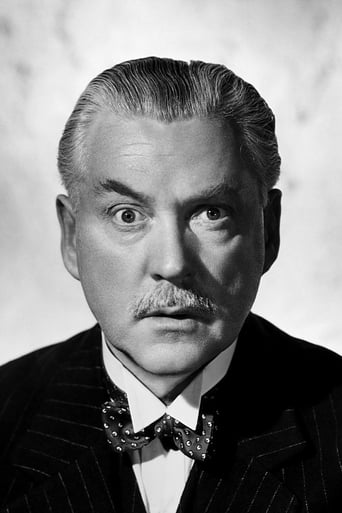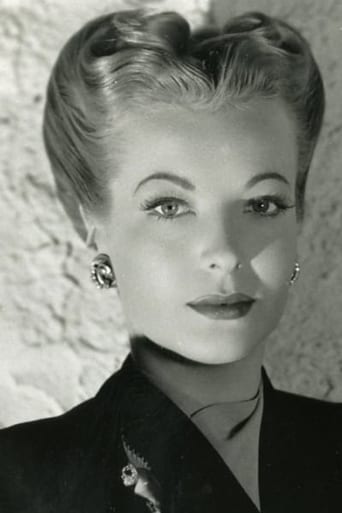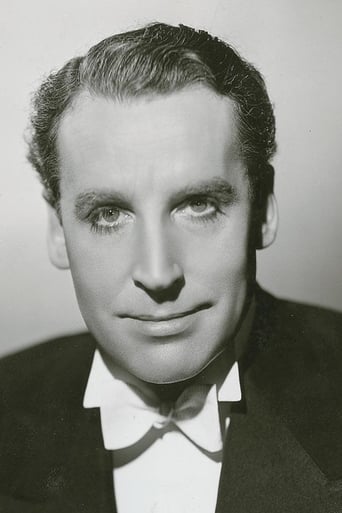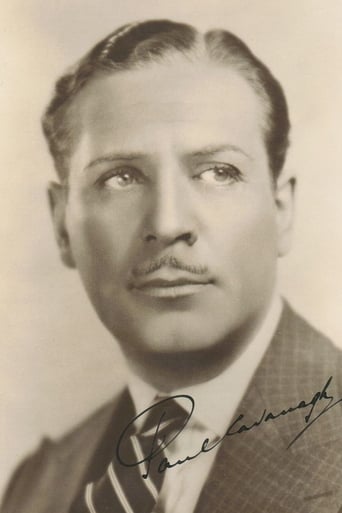GamerTab
That was an excellent one.
Portia Hilton
Blistering performances.
Derrick Gibbons
An old-fashioned movie made with new-fashioned finesse.
Cristal
The movie really just wants to entertain people.
Cristi_Ciopron
Hillary Brooke blesses this movie with her ineffable ease and subtlety, while Holmes watches for the public good. The movie is stylish and enjoyable (despite the absurd script, with some quite stupid subject matter, though it began well, with forebodings of a Ripper copycat), and Henry Daniell as Moriarty is vastly superior to the workmanlike Rathbone; Moriarty gives dignity to every scene he's in. Now to be fair, even in the stories, the mastermind was unlike all the rest, a less good idea of the author, but here Rathbone gets saddled with an over-the-top script, and the movie feels like another episode in one of the '60s TV series. Rathbone's role resembles a Dr. Who, with that unmistakable proletarian drive, an intellectualized proletarian, with none of the _reclusiveness nor the intensity (that gave him a certain eeriness) of the literary Holmes, Rathbone's Holmes is unintellectual and even a bit placid, save for the occasional bursts of energy, another person altogether, although, at Lydia's home, he looks a bit like Poe, the writer; but otherwise, his Watson is almost better. Rathbone is a good actor, here he is simply out-shined, surpassed by others in the cast.Genre-wise, it's not a mystery movie, but a melodrama, albeit a 'Universal' picture, immeasurably helped by some of the actors (H. Brooke, Daniell, Bruce). Apart from the script (a pure love letter to '40s melodramatic rubbish), it's an exciting movie, nicely crafted, with fine cast, production values, and directing; that is: they each stood for their rights, and worked with what they had, and got through.
AaronCapenBanner
Roy William Neil directed Basil Rathbone & Nigel Bruce as Sherlock Holmes & Doctor Watson. This time, a grisly series of murders of women where they had a finger cut off after death have been occurring, and Holmes is determined to solve them. The trail leads to the title character(though no reference to green is made, and as it's a Black & White film...) Also involved is Professor Moriarty, now played by Henry Daniell, taking over from Lionel Atwill, despite dying in "The Secret Weapon"(Huh?) Good cast of course, but film is dull, and lazily written, with Moriarty's involvement and ultimate fate absurd and uninspired. At least this was his last appearance!
Robert J. Maxwell
Diverting detective mystery in which the principal investigator's name happens to be Sherlock Holmes. If nothing else, it's good for late night viewing when drowsiness seems elusive. Also, Hillary Brooke carries around a lapidary glow that makes one long for the days when women's bathrobes had padded shoulders.This is the one about hypnosis. A number of young women have been killed around London and one of their fingers amputated and carried off. Men of prominence have been hypnotized by Hillary Brooke and Professor Moriarty and wake up near the murder site with the detached digit in their pockets. They are subsequently blackmailed. That's the plot in a nut shell.In the course of the investigation, Holmes plays a bit of violin music, the bumbling and muttering Nigel Bruce gets to be hypnotized during a visit to the Mesmer Club and make a fool of himself, and Holmes pretends to be hypnotized and coaxed into walking off a penthouse balcony.An incident is stolen from Conan-Doyle's "The Empty House," but nothing else will look very familiar to aficionados. The story and its execution are perfunctory. Holes are not worth going into. But, well, okay -- just one. The "hypnotized" Holmes must write a suicide note and he does so without looking down at what he's writing. It's just a small point but it's a signal that no one was paying much attention any longer to a series that was being ground out to keep the customers coming in and being entertained in a way that challenged nobody's sensibilities or intelligence.The device used to hypnotize Watson at the Mesmer Club is called an Archimides spiral and is useful for hypnotic inductions. I used one while collecting psychological data on visual after effects and one or two subjects began promptly nodding out. If anyone want to see what a visual after effect is like, he should locate a spiral -- they're around -- activate it and stare at it for about thirty seconds, then shut it off. You might not believe what happens next.
pyrocitor
It seems inevitable to expect that any film franchise could never stick to an established high standard of quality without the occasional slip, and such proved the case for the 1940s Basil Rathbone Sherlock Holmes films. Belying its striking, dramatic title and the credibility suggested by assembling its plot around sequences extracted from two of author Arthur Conan Doyle's most exciting Holmes stories (The Final Problem and The Adventure of the Empty House), the film's drop in quality from previous offerings is unmistakable and jarring, making it one of the weakest and least fun additions to the Rathbone pantheon.A point of interest is the film's topical influence, seemingly taking example from 1940s film noir detective films, both aesthetically, through its moody, tension inducing shadows and through a particularly detached and grim rendition of Holmes, almost as if styled after the prototype noir detective. Nonetheless, while an alternate 'feel' could have breathed intriguing new life into the film franchise, such aforementioned differences are largely where the innovation (and mostly quality) end. The Woman in Green proves unable to escape its frustratingly feeble script, reducing its characters to the worst kind of extremes and almost forgetting to develop its own mystery in the midst of unnecessary expositional sequences. While the narrative attempts to purloin and rekindle successful elements from past Holmes films (particularly The Spider Woman) by way of a seductively murderous femme fatale, the titular character is subsequently given little role or presence within the narrative, suggesting a hasty and under-explored last minute re-write. Similarly, while the incorporated motif of hypnotism boasts intriguing relevance and dramatic potential, it is only superficially developed, leaving the film lack the profundity as well as originality of its predecessors. Nonetheless, the largest fault of the film is its lacking any sort of scope or gravitas to match its implied drama. Despite with an insidious, borderline supernatural murder spree sweeping London, with the exception of a powerful early sequence with an amnesiac aristocrat lumbering through the city, struggling to come to terms with the horrific crime he seems to have committed, the film feels irritatingly contained and sparse, confined to few interior locations and giving little sense of the larger conflict unfolding, thus muting the drama and accessibility of the film. Moreover, the use of infamous antagonist Professor Moriarty feels like a lazy cash-in on an established character, as the timeless villain has little purpose in the narrative apart from skulking around and the occasional pseudo-ominous threat. His death scene, an offhand, uninteresting and borderline comical fall from a rooftop (a risible knockoff of his exhilarating plummet over Reichenbach falls in Conan Doyle's novel) aptly epitomizes the cheapening and neutered menace of the villain through his screen incarnation.While the inherent pleasure of seeing the usual players take centre stage cannot be denied, equally unmissable is their performances here being among their weakest. Basil Rathbone appears vaguely bored in his staple role as Holmes, seemingly attempting to compensate through overstated character quirks and frequently raising his eyebrows to emphasize 'important moments', though his snappy exchanges with Watson are as enjoyably disdainful as ever. Nigel Bruce appears particularly on autopilot as Dr. Watson, reduced to a broad comic foil of a buffoon more than ever (a sequence where he mocks hypnotism and is subsequently humiliated feels particularly unnecessary and embarrassing), and offering little of interest to counteract the poor script. Henry Daniell makes a particularly weedy and drab Moriarty, coasting by on the character's infamy with nonexistent presence and little threat. Hillary Brooke offers a dash of charisma and energy as the insidious titular woman in green, but her fleeting screen time offers his little chance to shine. While still retaining the inherent charm and fun of the Holmes franchise, The Woman in Green marks one of the most boring, under-thought and sloppily constructed offerings within it. While the irresistible Rathbone/Bruce combination offers enough to enjoy to make the film worth watching by more than Holmes purists, those interested would do better to partake in any of the ample selection of superior Holmes dramatizations.-6/10


